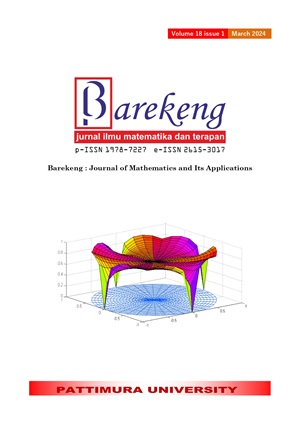FORECASTING THE NUMBER OF AIRPLANE PASSENGERS USING HOLT WINTER'S EXPONENTIAL SMOOTHING METHOD AND EXTREME LEARNING MACHINE METHOD
Abstract
Airplanes provide comfort and speed for their users, especially for those who have limited time. The number of passengers has continued to increase in the last few months at Ahmad Yani International Airport, so a forecast is needed in making decisions to predict the number of passengers in order to maximize existing performance. The data used is secondary data on the number of airplane passengers at Ahmad Yani International Airport from 2012 to 2022 obtained from PT Angkasa Pura 1 (Persero). The Holt Winters Exponential Smoothing method is used because it aligns with the data pattern that includes trends and seasonality in the research, and it has a low level of accuracy. In this study also used the Extreme Learning Machine (ELM) method, apart from being a relatively new method, it has a fast learning speed and has low accuracy. This study aims to predict the number of airplane passengers at Ahmad Yani International Airport in Semarang using the Holt Winters Exponential Smoothing and ELM methods. The results of the analysis show that the MAPE value in the Holt Winters Exponential Smoothing method is 8,18% and in the ELM method using 12 input neurons and 43 neurons in the hidden layer, a MAPE of 6,04% is obtained. so that the ELM method is the right method for predicting the number of airplane passengers at Ahmad Yani International Airport in Semarang.
Downloads
References
F. Lamusa, “Peramalan Jumlah Penumpang Pada PT.Angkasa Pura I (PERSERO) Kantor Cabang Bandar Udara Internasional Sultan Hasanuddin Makassar Dengan Menggunakan Metode Holt-Winters Exponential Smoothing,” UIN Alauddin Makassar, 2017.
M. T. Ikhsan, D. Rusadi, and M. Ghalih, “Analisis Pengaruh Jumlah Keberangkatan Penumpang di Bandara Pada Penerbangan Domestik dan Internasional di Indonesia,” J. Ris. Akunt. Politala, vol. 2, no. 1, pp. 8–15, 2017.
PT Angkasa Pura I (Persero). "Data Bulanan Jumlah Penumpang Pesawat Bandara Internasional Ahmad Yani Tahun Januari 2012 sampai Desember 202" PPID PT Angkasa Pura I (Persero). Diakses tanggal 29 Maret 2023, dari https://ppid.ap1.co.id/
M. Mohan, P. C. Kishore Raja, P. Velmurugan, and A. Kulothungan, “Holt-Winters Algorithm to Predict the Stock Value Using Recurrent Neural Network,” Intell. Autom. Soft Comput., vol. 35, no. 1, pp. 1151–1163, 2023, doi: 10.32604/iasc.2023.026255.
I. K. A. G. Wiguna, N. L. P. A. C. Utami, W. G. S. Parwita, I. P. A. E. D. Udayana, and I. G. I. Sudipa, “Rainfall Forecasting Using the Holt-Winters Exponential Smoothing Method,” J. Info Sains Inform. dan Sains, vol. 13, no. 01, pp. 15–23, 2023.
Z. M. Yaseen, S. O. Sulaiman, R. C. Deo, and K. W. Chau, “An enhanced extreme learning machine model for river flow forecasting: State-of-the-art, practical applications in water resource engineering area and future research direction,” J. Hydrol., vol. 569, no. November 2018, pp. 387–408, 2019, doi: 10.1016/j.jhydrol.2018.11.069.
A. Giusti, A. W. Widodo, and S. Adinugroho, “Prediksi Penjualan Mi Menggunakan Metode Extreme Learning Machine ( ELM ) di Kober Mie Setan Cabang Soekarno Hatta,” J. Pengemb. Teknol. Inf. dan Ilmu Komput. Univ. Brawijaya, vol. 2, no. 8, pp. 2972–2978, 2018.
A. Nurdini and A. Lazuardy, “Analysis of Demand Forecasting for Tempeh Products At Indonesian Tempeh Houses Using the Holt-Winters Additive Method Approach,” Int. J. Sci. Technol., vol. 2, no. 1, pp. 59–64, 2023, doi: 10.56127/ijst.v2i1.854.
N. A. Izati, B. Warsito, and T. Widiharih, “Prediksi Harga Emas Menggunakan Feed Forward Neural Network Dengan Metode Extreme Learning Machine,” J. Gaussian, vol. 8, no. 2, pp. 171–183, 2019, doi: 10.14710/j.gauss.v8i2.26641.
T. Widiyaningtyas, I. Ari Elbaith Zaeni, and T. Ismi Zahrani, “Food Commodity Price Prediction in East Java Using Extreme Learning Machine (ELM) Method,” Proc. - 2020 Int. Semin. Appl. Technol. Inf. Commun. IT Challenges Sustain. Scalability, Secur. Age Digit. Disruption, iSemantic 2020, pp. 93–97, 2020, doi: 10.1109/iSemantic50169.2020.9234201.
T. Safitri, N. Dwidayati, and K. Kunci, “Perbandingan Peramalan menggunakan Metode Exponential Smoothing Holt Winters dan Arima,” Unnes J. Math., vol. 6, no. 1, pp. 48–58, 2017, [Online]. Available: http://journal.unnes.ac.id/sju/index.php/ujm
C. Liu, B. Sun, C. Zhang, and F. Li, “EnerarXiv-preprint EnerarXiv-preprint,” pp. 1–27.
N. Nurhamidah, N. Nusyirwan, and A. Faisol, “Forecasting Seasonal Time Series Data Using the Holt-Winters Exponential Smoothing Method of Additive Models,” J. Mat. Integr., vol. 16, no. 2, p. 151, 2020, doi: 10.24198/jmi.v16.n2.29293.151-157.
G. Bin Huang, Q. Y. Zhu, and C. K. Siew, “Extreme learning machine: A new learning scheme of feedforward neural networks,” IEEE Int. Conf. Neural Networks - Conf. Proc., vol. 2, pp. 985–990, 2004, doi: 10.1109/IJCNN.2004.1380068.
F. N. Cholisa, “Prediksi Penjualan Minuman Kopi Menggunakan Metode Extreme Learning Machine (ELM),” Universitas Islam Negeri Maulana Malik Ibrahim Malang, 2021.
I. Abadi, A. Soeprijanto, and A. Musyafa’, “Extreme learning machine approach to estimate hourly solar radiation on horizontal surface (PV) in Surabaya -East java,” 2014 1st Int. Conf. Inf. Technol. Comput. Electr. Eng. Green Technol. Its Appl. a Better Futur. ICITACEE 2014 - Proc., no. September, pp. 372–376, 2015, doi: 10.1109/ICITACEE.2014.7065774.
Copyright (c) 2024 Rochdi Wasono, Yulia Fitri, M. Al Haris

This work is licensed under a Creative Commons Attribution-ShareAlike 4.0 International License.
Authors who publish with this Journal agree to the following terms:
- Author retain copyright and grant the journal right of first publication with the work simultaneously licensed under a creative commons attribution license that allow others to share the work within an acknowledgement of the work’s authorship and initial publication of this journal.
- Authors are able to enter into separate, additional contractual arrangement for the non-exclusive distribution of the journal’s published version of the work (e.g. acknowledgement of its initial publication in this journal).
- Authors are permitted and encouraged to post their work online (e.g. in institutional repositories or on their websites) prior to and during the submission process, as it can lead to productive exchanges, as well as earlier and greater citation of published works.






1.gif)



